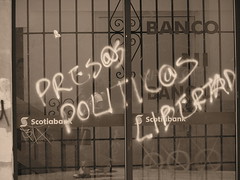Locating Ourselves
The road to Oaxaca leads out of Mexico City amid the sprawling slums and climbing hillsides of central Mexico. Small cars and motorcyclists vie for position among the buses and trucks bent on long hauls in short time. Beyond the population centers, central and southern Mexico opens onto vast plains of desert, interrupted to the south by the striking bluffs and volcanic mountains of the San Madre de Oaxaca. At one point on our climb, traveling slowly across a section of new bridge spanning a massive arroyo, hundreds of feet down, the steady clouds relented and showed us the snowy top of a weathered mountain. Tall specimens of saguaro cactus point to the sky in this part of the high desert. Yucca plants mature to great size, the spindles that display their blooms falling over seasonally from height and age. We climb beyond the saguaro and the yucca, then level out on the crests above the Valles Centrales, or Central Valleys.
Oaxaca City lies in the northwest of the Valles Centrales. Ringed by hills and mountains, the city expands across the valley floor in steppes and stages. From the roadway above the city I make out what a Oaxacan passenger tells me is the second class bus terminal, the corrugated awnings of the bus ports spread in a large circle, nearly complete, unfolded as the shape of a paper fan on the valley floor. We descend gradually into the neighborhoods on the outskirts of town, and then into the city itself.
Traffic in Oaxaca is crowded and bustling, but not so much as Mexico City. The city hosts a population a little over a quarter million, and though there is a certain busy-ness about the place there is not the overt crush of people and traffic that I experienced, briefly, in the capital. Right away I notice greater numbers of indigenous Indians, descendants of Zapotec and Mixtec tribes, than in the north. The farther south we travel the shorter many people seem to get. Already I have seen some of the shortest women in the world here. More vendors sell simple food and crafts than where we stayed in Mexico City. The closer we get to central downtown and the zocalo, the more abundant are the vendors at their tables, under tarps, on bicycles equipped to sell corn, fruit or tortas, or simply walking the sidewalks with tortillas or sweets in hand.
It's a short walk from the bus station to Hotel Las Mariposas. A little more expensive than several of the hostels in town, Hotel Las Mariposas is worth the extra pesos for the quiet, clean rooms, quiet courtyards away from busy streets, and attentive staff. In the mornings there is coffee heavily spiced with cinnamon. Free wireless internet keeps me in blog posts, and the hotel's location northeast of the city center offers a break from the heavily touristed areas several blocks to the south. We made a tour of less expensive locations where we might stay over the weekend until we rent an apartment or rent rooms with a family, but we quickly realized the value of being a little outside of things. The extra pesos we pay each night gets us off the busy streets and prices us out of the bargain backpackers' range, which means less chance of young Americans getting drunk in the courtyard and making noise late at night. We spent the morning talking about the importance of saving our money. By mid-afternoon we congratulated ourselves on the benefits an extra ten dollars will buy.
Tags: Oaxaca, Hotel Las Mariposas



|